The Fifth Kingdom - Chapter 22
POISONOUS AND HALLUCINOGENIC MUSHROOMS
IntroductionA man is brought to the Emergency Department of a hospital suffering from diarrhea, abdominal cramps, nausea and vomiting. His problem is diagnosed as gastro-enteritis. He is given atropine, donnatal, and intravenous fluids to combat dehydration, then sent home. The vomiting and diarrhea go on for another 24 hours. By now he is severely dehydrated, and has to be admitted to hospital. Over the next two days, his liver, kidney and heart begin to fail. Despite treatment of his symptoms with a battery of antibiotics, corticosteroids, vitamins, stimulants and intravenous fluid, he dies.
This is a true story. The only thing I didn't tell you was that the man had eaten a meal of wild mushrooms about 12 hours before the onset of his symptoms. By the time you have read this chapter, you should be able to diagnose his illness correctly, and suggest treatments that might have saved his life.
People can conveniently be divided into two groups: those who love to eat wild mushrooms, and those who would never dream of doing such a thing. There doesn't seem to be any middle ground on this issue: you are either a `picker' or a `kicker.' This characteristic seems to be culturally determined. Most people of Anglo-Saxon origin are kickers, while those from Central and Eastern Europe are pickers. Picking is a pastime that occasionally gets them into trouble. There are about 10,000 different species of fleshy fungi. The vast majority are perfectly innocuous. A relatively small number are hunted for their delicious flavour, and a cooperative few have been domesticated (see chapter 18). But another few are deadly poisonous, and many others can cause more or less serious discomfort if they are unwittingly eaten. During the course of human history I would suspect that all 10,000 species of agarics have been eaten. This chapter considers what we have learned from the trying, tragic or transcendental experiences of those who made random or unconventional choices of mushroom for their free meal.
The main problem is one of identification. There is no simple rule or test that will tell whether a mushroom is edible or deadly poisonous. Many people are blissfully unaware of this, and rely on tests which are irrelevant and fallacious. They are playing Russian roulette. You should eat wild mushrooms only if you know, or can determine, their scientific names. If you are sure, from observation (some of it through the microscope), or experience, that all of a particular collection of fungi belongs to, say, Cantharellus cibarius (the chanterelle), or Morchella esculenta (the morel), and that the fruit bodies are young and freshly picked, experience tells us that you can eat and enjoy them, as mycophagists have done for thousands of years (though some people are allergic to mushrooms). Every year, many people take unnecessary chances by eating unfamiliar mushrooms, or confuse poisonous species with edible ones, and every year some unfortunates are fatally poisoned.
Since most North Americans are kickers, they tend not to become mushroom poisoning statistics. Europeans, however, are pickers, and have suffered as many as 100 fatalities in two weeks. In 1975, a Swiss newspaper reported 54 local deaths during a short period in late summer. Which fungi killed these people? What are the toxins involved? We recognize eight different kinds of mushroom poisoning, which are listed in the Table. A quick look at this table will show that fatalities are usually caused only by groups I, II and III. In fact, 50% of all serious mushroom poisonings, and 95% of all fatalities, are caused by members of a single genus, Amanita, which fruits in late summer and fall. Group I -- Amanitin PoisoningAs a result of many inadvertent, and often fatal, experiments made by hapless
or foolhardy volunteers, we can say that the basidiomata of several species of the agaric
genera Amanita and Galerina contain toxins that are lethal to humans in
extremely small doses. Amanita virosa (the `destroying angel'), Amanita
phalloides (the `death cap'), and closely related species are notorious killers. They
contain such high levels of toxin that a single bite can be fatal to a debilitated
individual. The toxin molecules are made up of amino-acids in a double ring, and so are
called cyclic oligopeptides or cyclopeptides. They come in two varieties, known as
amatoxins (amanitins), which contain 8 amino-acid molecules, and phallotoxins
(phalloidins), which contain 7 amino-acid molecules. When injected into mice, the
phallotoxins are ten times more lethal than cyanide: their LD50 is 2 mg/kg. But
when taken by mouth, they have no effect. They may be neutralized or broken down by
digestive juices, or may not be absorbed by the gut. In contrast, the much more deadly
amatoxins are actively toxic when eaten (LD50 = 0.1 mg/kg).
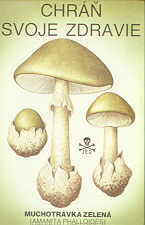
A Czech poster warning about Amanita phalloides (death
cap) - source of the deadly amanitins. This fungus was found on Vancouver
Island for the first time in 1998.
Amatoxins rapidly damage intestine, kidney and liver. Alpha-amanitin attacks
the nucleus of cells, binding to RNA-polymerase II, the enzyme that transcribes DNA and
produces messenger RNA. The synthesis of RNA ceases, and so, as a direct consequence, does
the synthesis of protein. This ultimately brings the machinery of the cell to a
standstill, and it dies. Cells of the intestinal lining, liver and kidney have a rapid
turnover, so their loss and non-replacement will soon have serious effects on the
organism. This is bad news, but there is worse to come. We still have no specific antidote
to these toxins. And worst of all, the outward symptoms of amatoxin poisoning do not begin
until after a great deal of the cell damage has been done. This makes it one of the most
difficult forms of poisoning to treat.
One important step in understanding what may be going on in a poisoning case is to ascertain whether the mushrooms in the case contain amatoxins. The Meixner test provides a simple (though perhapsot very reliable) way of doing this. Liquid is squeezed from a piece of the fresh mushroom into a circle marked on a piece of newspaper, and allowed to dry (perhaps with a little help from a hair-dryer). A drop of concentrated hydrochloric acid is added to the dried spot. A blue colour, developing at any time over the next 20 minutes, indicates the presence of amatoxins. If the toxin is present in the agaric at high levels, the colour will probably develop in 1-2 minutes. Newsprint must be used, rather than high-quality paper, because the test is based on a reaction between amatoxin and lignin, which is catalyzed by the acid. A negative test does not prove that an agaric is edible.
The most poisonous mushroom in eastern North America is probably Amanita
virosa. The large basidiomata of this innocent-looking species are pure white
throughout, and have both ring and volva.

The pure white, but deadly, Amanita virosa.
In the West, the situation is complicated by the presence of Amanita
phalloides, with an often greenish cap, which is probably just as toxic as A.
virosa. Those who have eaten these species report that they have a mild flavour.
Subsequent events may be divided into four stages. (1) A latent period of 6-24 hours, most commonly about 12 hours. This asymptomatic interlude is long enough that the patient frequently does not even connect the subsequent illness with mushrooms. During this hiatus,the amanitin is attacking the cells of the liver, kidney and intestine. (2) Violent vomiting, diarrhea and abdominal pain, which last for a day or so. (3) A brief, misleading remission of symptoms. (4) Collapse of kidney and liver function, with secondary effects on the heart and brain, leading to coma and death.
Relatively few species of Amanita contain amanitins, and a few members
of other genera produce these toxins in significant amounts. Galerina autumnalis
is one such.

Some species of Lepiota also contain amanitins, as does Conocybe
filaris.
What can be done for victims of amanitin poisoning? The biggest problem is the long delay
in the appearance of overt symptoms. By the time the patient seeks medical aid, massive
cell damage may already have been done. The first hurdle is to arrive at a correct
diagnosis. Amanita poisoning is relatively rare in North America, and many
doctors may not think of it unless the patient mentions mushrooms. Even then, most
physicians (and this is no discredit to them) know virtually nothing about diagnosing
mushrooms. No identifiable specimens may be available. With luck, the local mycologist
will be called in, and will recognize the danger inherent in the delayed symptoms. Even if
the problem is correctly diagnosed, there is currently no antidote for amanitin. Treatment
consists of attempts to: (1) remove toxin from the system; (2) increase the rate at which
the patient excretes it; (3) support the patient's various systems.
(1) Removal of toxin. If the condition is diagnosed within an
hour or two, it is obviously appropriate to empty the stomach by emesis and gastric lavage
(getting the patient to throw up, and then washing out the stomach). If the usual latent
period has elapsed, this approach would be pointless. Three blood-cleansing techniques
have been applied to late-diagnosed amanitin poisoning. (A) Haemodialysis (circulating the
blood through a semipermeable membrane bathed in an isotonic medium) is used in long-term
treatment of kidney failure, or until a transplant becomes available. Its use in Amanita
poisoning is questionable, since it removes substances of molecular weight 300 or less.
Amanitin itself has a molecular weight of 900, and it may often become complexed with much
larger molecules, such as proteins. Nevertheless, in serious cases, where kidney failure
threatens, haemodialysis may be useful under heading 3. (B) Haemoperfusion (circulating
the blood over activated charcoal) is used to support the detoxifying function of ailing
livers. It has been used experimentally to treat Amanita poisoning in recent
years, and has been shown to remove some toxin from amanitin-spiked blood.
Unfortunately, the amounts of amanitin detected in the blood of poisoning victims are
usually very low, especially if more than 12 hours have elapsed since the mushrooms were
eaten. Keeping in mind the possible unfavourable effect of haemoperfusion on a blood
coagulatory pattern already unbalanced by the effects of the toxin, this technique should
be applied with caution. It may, of course, be indicated if the effects of the toxin cause
liver failure. (C) Apheresis (centrifuging the blood to segregate its major components --
plasma, erythrocytes, leucocytes, platelets -- then discarding and replacing the fraction
containing the unwanted agent) is being increasingly used to treat many diseases of the
immune system, and some kinds of poisoning. Again, the actual kinetics of amanitin in the
body are not yet well-enough understood for us to be sure which blood fraction, if any,
should be replaced. This technique may prove to be of value when the movements of amanitin
in the body are better understood.
(2) Increase excretion of toxin. Although the body's natural
excretion of amanitin is obviously not efficient enough to prevent cell damage, a new and
sensitive radioimmunoassay for amanitin in body fluids has shown that the toxin is present
in the urine of patients at far higher levels than can be found in their blood. This
suggests that attempts to increase urine production by giving intravenous fluids, and an
appropriate diuretic, might be helpful.
(3)
Supportive measures involve careful monitoring of electrolyte and fluid balance,
and blood sugar, with appropriate replacement therapy as required. Liver and kidney
functions must be closely followed. If kidney and/or liver failure occurs, haemodialysis
and/or haemoperfusion may be necessary. In addition, various researchers have suggested
several other strategies to support the damaged liver or kidneys: intravenous infusion of
B vitamins, vitamin K, Penicillin-G, corticosteroids, and thioctic acid (a coenzyme in the
Krebs cycle). The therapeutic value of some of these agents has not been firmly
established, but in a potentially fatal condition, the shotgun approach is worth trying.
The Bastien Treatment
A French physician, Dr. P. Bastien, has developed a new treatment for Amanita
poisoning. It has three parts: (1) intravenous injections of 1 gram vitamin C twice a day;
(2) two capsules of nifuroxazide three times a day; (3) two tablets of dihydrostreptomycin
three times a day. The treatment is supplemented by measures to control fluid and
electrolyte balance, and by penicillin. Bastien successfully treated 15 cases of A.
phalloides poisoning between 1957 and 1969. In 1974 he ate 65 grams of A.
phalloides and survived. In 1981 he ate 70 grams of A. phalloides and again
successfully treated himself. It is reported that the Bastien treatment is now used
throughout France, where it saves the lives of all those whose treatment has not been
delayed until massive liver and kidney damage has occurred. This method should obviously
be widely publicized and tested in North America.
Amanitin-eating flies

This species is responsible for 2-4% of all fatal mushroom poisonings. Over a ten-year period in Poland, 100 people were hospitalized, and 6 died, as a result of eating Gyromitra. The toxin precursor in G. esculenta is called gyromitrin. When this is hydrolyzed, it becomes monomethylhydrazine (MMH), which is used as a rocket fuel, and is, as researchers for the space program realized, extremely toxic. All species of Gyromitra are poisonous when raw, boiled or fried. Reports that those who ate the mushrooms were unaffected, while the cook became ill, were often discounted. But there is a rational explanation of these seemingly bizarre stories. The monomethylhydrazine has a boiling point of 87.5C, and its vapours are toxic. Certain cases in which some diners were unaffected, while others became very ill, were also difficult to explain until it was shown that there is a narrow margin between no effect and a lethal dose -- an `all-or-nothing' response. The same individual could eat Gyromitra several times without apparent effect, then on one occasion unwittingly exceed the limit and be poisoned. Symptoms of poisoning appear 2-12 hours (typically 6-8 hours) after the meal. An initial bloated feeling is followed by nausea, vomiting, diarrhea and abdominal cramps. Victims often experience faintness, loss of muscular control, and fever. In severe cases, jaundice and convulsions occur, and coma and death may ensue after 2-7 days.
The delay in the onset of symptoms gives a clue to the action of the toxin. As with the cyclopeptides, it is at the cellular level. It is haemolytic, toxic to the central nervous system, irritates the gastro-intestinal tract, and damages the liver. Methaemoglobin and free haemoglobin are present in the blood. Levels of bilirubin and liver enzymes rise, and blood sugar falls. Unless the toxic nature of the mushroom is diagnosed almost immediately after it has been eaten, there is little point in evacuating the gut. Pyridoxine hydrochloride should be administered as a specific physiological antagonist of MMH. The patient's blood sugar, liver and kidney function, and free haemoglobin level should be monitored. Intravenous glucose, forced diuresis if free haemoglobin rises, haemodialysis in severe cases, and other supportive measures, may be needed.
Group III -- Orellanine Poisoning
In 1957 a report emerged from Poland of three outbreaks of mushroom poisoning caused by eating Cortinarius orellanus. Among 132 people poisoned, 19 died. Death was caused by kidney failure, and in most cases occurred two to three weeks after symptoms began (though some children died within a few days, and other deaths were delayed for months). The most unusual feature of this poisoning was the extremely delayed onset of symptoms. Even in severe and ultimately fatal cases, no symptoms were reported until 3-4 days after the mushrooms had been eaten. In milder cases, the latent period was longer, extending to 10-17 days.
Initial symptoms were an intense thirst, accompanied by burning and dryness of the mouth. Headache, chills, loin or abdominal pain, nausea and vomiting followed. Although urination was initially stimulated, it was soon reduced and in some cases ceased altogether. In serious cases, the BUN (blood urea nitrogen) rose, as might be expected following kidney damage.
Once this form of poisoning had been recognized and described, it was reported
from France, Germany, Switzerland, and Czechoslovakia. No confirmed cases have been
reported in North America. The nephrotoxin involved is called orellanine, and has been
detected in another European species, Cortinarius orellanoides...
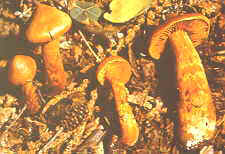
...as well as in the North American species, Cortinarius
rainierensis. Orellanine has an oral LD50 (cat) of 4.9 mg/kg. It is
estimated that 100-200 g of fresh C. orellanus contains enough orellanine to
cause complete kidney failure. Although there do not appear to be any reports of kidney
transplants in the literature, that procedure would now seem to be an appropriate response
to total renal shutdown.

Strangely enough, the mushrooms by themselves are not toxic. Symptoms appear 30-60 minutes after the mushroom-eater has a drink containing alcohol: they include hot flushes of the face and neck, a metallic taste in the mouth, tingling sensations in the limbs, numbness in the hands, palpitations, a throbbing headache, nausea and vomiting. This is an unpleasant combination, but it isn't fatal. The only treatment necessary may be to control arrhythmia (irregular heartbeat). The syndrome will persist as long as there is any alcohol in the system -- usually 2-4 hours -- after which recovery is spontaneous, and the victim may well swear off booze.
The condition arises because Coprinus atramentarius contains coprine, a unique amino acid that blocks the metabolism of ethyl alcohol at the acetaldehyde stage. Coprine poisoning is really acetaldehyde poisoning. The rather excessive duration of this potential booby-trap for drinkers is due to the persistence of coprine in the body. Antabuse (disulfiram), which is prescribed to help alcoholics stay on the wagon, has an action almost identical to that of coprine, though the two substances are chemically different.
Group V -- Muscarine Poisoning -- PSL SyndromeIt is a good idea to avoid eating little white or brown mushrooms that grow in the grass, since some members of two common genera, Clitocybe and Inocybe, contain significant amounts of muscarine.
Clitocybe dealbata

Inocybe lanuginella
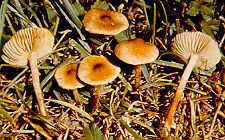
Inocybe fastigiata

This is a toxin that, within 30 minutes to 2 hours of being consumed, sends the exocrine glands -- the producers of sweat, saliva and tears -- into top gear in what is called the 'PSL' syndrome (perspiration, salivation, lachrymation), and also causes constriction of the pupils, blurred vision, muscle spasms, diarrhea, slow heartbeat, and a drop in blood pressure. The only real danger here is that the heart may actually stop, if enough toxin has been absorbed. This has happened only rarely, and then in patients with existing cardiovascular disease. The appropriate treatment is carefully administered intravenous atropine. Group VI -- Ibotenic Acid-Muscimol 'Poisoning' Earlier in this chapter I described what happens when someone eats the deadly species of Amanita, those containing amatoxins. But other species of Amanita produce very different effects. Amanita muscaria, the famous scarlet-capped, white-spotted mushroom so beloved of fairy-tale illustrators, is one of these

It induces muscle spasms, dizziness (and vomiting, if too many mushrooms have been eaten), then a deep sleep, full of fantastic dreams, lasting about 2 hours. On waking, the subject usually experiences a 'good trip': a feeling of elation that persists for several hours. People often become hyperactive, making compulsive and uncoordinated movements, perhaps talking non-stop, and having altered perceptions of reality. Occasionally the experience is a 'downer.' Clearly, Amanita muscaria contains a substance that specifically affects the central nervous system. Needless to say, this was discovered long ago, and has been exploited by various peoples. The Soma hymns of the 3,000-year-old sacred Indian book, the Rig Veda, have been interpreted as a glorification of A. muscaria and its effects.
...quite a billing to live up to! Does Amanita muscaria really have such awesome qualities? I don't recommend that you experiment.

Amanita muscaria portrayed as the tree of the knowledge of good and evil in an old fresco at the Abbaye de Plaincourault, Mérigny, France.

Many tribes in Siberia used it for centuries as a religious or recreational intoxicant, and although it has now largely been replaced by vodka, some Siberians still prefer mushrooms.
Historical accounts suggest that the active principle is not destroyed in the body, but is excreted unaltered in the urine. Probably by watching their reindeer, which have a fondness for urine, the Siberians learned that the inebriant could be recycled. When mushrooms were in short supply, and only the richer tribesmen could afford them, the poor folk waited for the guests to relieve themselves, then drank the intoxicating liquid. Clearly, the motivation must have been very strong.
Although fresh mushrooms contain ibotenic acid, which has some effect on the nervous system, dried mushrooms have been found to be much more potent. This is because ibotenic acid degrades to muscimol on drying. Muscimol is 5-10 times more psychoactive than ibotenic acid. Dried mushrooms retain their potency for 5-10 years. Although very few deaths have been reported from this kind of poisoning, 10 or more mushrooms can constitute a fatal dose.
In most cases, the best treatment is no treatment. Recovery is spontaneous and
complete within 24 hours. If many mushrooms have been eaten, severe convulsions may have
to be controlled, and the stomach should be emptied. On no account should atropine be
given: it will exacerbate the symptoms.
a charming rendition of A. muscaria as the fly agaric, by
the French artist M. Sabatier.

Group VII -- Psilocybin-Psilocin `Poisoning'
a Mexican curandera administering the sacrament of the mushrooms
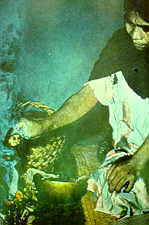
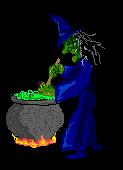
The practice was suppressed by the 'Christian' Spanish
Conquistadors, as smacking too much of witchcraft, and the secret of Teonanacatl was lost
to the outside world until the twentieth century. The story of its rediscovery is a
mycological classic. After penetrating the wall of silence with which the people of Oaxaca
protected their shamanic ceremonies, two Americans were eventually allowed to participate,
and to partake of the sacred mushrooms. After eating the mushrooms, they waited with their
hosts, in the dark. The two visitors vomited. Again they waited. Nothing happened. Then
one whispered to the other `I'm seeing things.' 'That's all right,' said the other, 'so am
I.' One of them later described the visions as being 'in colour... kaleidoscopic... they
were angular and they would go fast or slow, responding to my wishes...I had delightful
feelings...euphoria, peaceful feelings. The effects lasted about 4½ hours. Then
imperceptibly we all...fell asleep on the ground.'
After many similar experiences, the same author wrote: 'The sacred mushrooms of Mexico seize hold of you with irresistible power. They lead to a temporary (state)...in which your body lies, heavy as lead, on the mat, and you take notes and compare experiences with your neighbour, while your soul flies off to the ends of the world and, indeed, to other planes of existence... some seem to experience only a divine euphoria, which may translate itself into uncontrollable laughter... I experienced hallucinations... visions of palaces, gardens, seascapes, and mountains... With the speed of thought you are translated wherever you desire to be, and you are there, a disembodied eye, poised in space, seeing, not seen, invisible, incorporeal. I have placed stress on the visual hallucinations, but all the senses are equally affected, and the human organism as a whole is lifted to a plane of intense experience. (Everyday experiences are) transformed, leaving you breathless with wonder and delight. The emotions and intellect are similarly stepped up. Your whole being is aquiver with life.'
Experiences like these can be triggered by members of four agaric genera: Psilocybe,
Panaeolus, Conocybe, and Gymnopilus. The Mexican rites usually
employ one of several Psilocybe species, particularly P. caerulescens, P.
zapotecorum and P. mexicana. In the United States, and in coastal areas of
British Columbia, devotees of `magic mushrooms' often collect hallucinogenic species of Panaeolus
and Conocybe. Psilocybe species are often cultivated, since spore prints
of, for example, Psilocybe cubensis can be ordered by mail...
The cover of a guide to growing magic mushrooms (Psilocybe
cubensis)..

a picture from the book above...of young Psilocybe cubensis
(Strophariaceae)...

...and another, of mature Psilocybe cubensis.
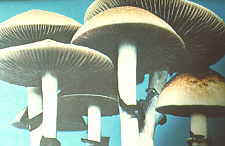
dried magic mushrooms, as found 'on the street
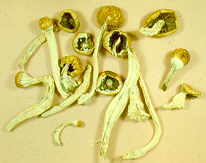
People in the Pacific Northwest avidly hunt for Psilocybe semilanceata
and P. pellicula, which are the fabled `liberty caps.'
A pictorial survey of some psilocybin-containing magic mushrooms

The psychoactive principles in these agarics are indole alkaloids called
psilocybin and psilocin, hydroxyltryptamine derivatives related to the neurotransmitter,
serotonin. An average effective dose of psilocybin is 4-8 mg, the amount contained in
about 2 g of dried mushrooms. If larger quantities of mushrooms are eaten, the
hallucinogenic effects may be rather overwhelming, but serious poisoning is unlikely
unless huge numbers of mushrooms are consumed. Adults on `bad trips' may become extremely
anxious or even paranoid, and may need considerable reassurance or, more rarely,
tranquilizers. Children who eat hallucinogenic mushrooms may develop a high fever or
convulsions. They should not be given aspirin. Tepid baths or wet sheets should be used.
Hallucinations may be suppressed by chlorpromazine, and convulsions by diazepam.
Panaeolus foenisecii, which contains traces of
psilocybin.

Gymnopilus spectabilis (big laughing Gym), also
producing some psilocybin..

Alice meets the caterpillar...who gives her some of his magic mushroom
(illustration by Tenniel)... Many of the episodes recounted in 'Alice in Wonderland' have
a strangely hallucinogenic quality.
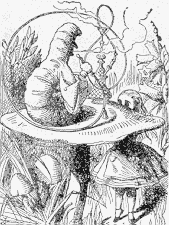
Alice in Wonderland bronze mushroom sculpture in Central Park, New York

Group VIII -- Gastro-Intestinal Irritants
Little or nothing is known about the toxins involved, though the diversity of
fungi causing these symptoms suggests that a number of different substances may eventually
be implicated. Digestive disturbances can be caused by various members of the following
genera: Agaricus, Amanita, Boletus, Chlorophyllum, Entoloma,
Hebeloma, Lactarius, Marasmius, Naematoloma, Omphalotus,
Pholiota, Russula, Scleroderma, Tricholoma, and
possibly many others. Since we don't know what chemicals are causing the problem,
treatment is restricted to emptying the stomach and, in elderly or debilitated patients,
monitoring for dehydration, reduced blood pressure or impaired kidney function. Occasional
fatalities have been caused by almost all of these fungi.
Boletus satanas - unspecified GI toxins

Boletus splendidus - unspecified GI toxins

Mechanisms of Toxicity
If we look back on the various kinds of poisoning examined in this chapter, and try to analyze the mechanisms involved, we can discern four basic patterns:
(1) Toxins that cause extensive cell destruction, but which produce overt symptoms only after a significant, and potentially fatal, delay (amanitin, orellanine, monomethylhydrazine).
(2) Toxins that act on the autonomic nervous system, causing symptoms either as soon as they have been absorbed, or whenever the appropriate substrate enters the system (muscarine, coprine).
(3) Toxins that act on the central nervous system, causing symptoms as soon as they have been absorbed (muscimol, psilocybin).
(4) Undetermined toxins that act on the alimentary canal, causing symptoms as soon as they have been absorbed.
Perhaps it is worthwhile, after that rather alarming litany of toxic effects, to suggest again that unless you are a mushroom expert, you should either refrain from eating wild mushrooms altogether, or stick to a few species whose characteristics you have learned in great detail. In addition to checking your fungi in the `Audubon Society Field Guide to North American Mushrooms' by Lincoff, or `Mushrooms Demystified' by Arora, I recommend `Funghi Velenosi' by Azzaretti et al., which has excellent colour pictures of most of the really dangerous species. In any case, if someone you know should be unfortunate enough to be poisoned by mushrooms, you will now be in a position to offer some practical advice, even to the medical profession.
| Mushroom Toxins and their Occurrence | |
|---|---|
| Toxins | Fungi |
| I - Amanitins (cyclopeptides) |
Amanita bisporigera, A. ocreata, A. phalloides,
A. verna, A. virosa, etc.; Galerina autumnalis, G. marginata, etc.; Lepiota spp. Conocybe filaris. |
| II - Gyromitrin, monomethylhydrazine | Gyromitra brunnea, G. caroliniana, G. esculenta, G.
fastigiata, G. infula; (?) Helvella elastica, (?) H. lacunosa; (?) Paxina spp. Sarcosphaera crassa. |
| III - Orellanine | Cortinarius orellanus, C. orellanoides, C. rainierensis. |
| IV - Muscarine | Clitocybe cerussata, C. dealbata, C. rivulosa, C.
sudorifica; Inocybe geophylla, I. lilacina, I. pudica. |
| V - Ibotenic acid, muscimol | Amanita cokeri, A. cothurnata, A. gemmata, A.
muscaria, A. pantherina; (?) Panaeolus campanulatus |
| VI - Coprine | Coprinus atramentarius, (?) Coprinus spp.; Clitocybe clavipes. |
| VII - Psilocybin, psilocin | Conocybe cyanopus; Gymnopilus spectabilis, Gymnopilus
spp.; Panaeolus foenisecii, P. subbalteatus; Psilocybe cubensis, P. cyanescens, P. semilanceata, P. silvatica. |
| VIII - Gastrointestinal irritants | Agaricus hondensis, A. placomyces; Amanita brunnescens; Boletus luridus, other blueing Boletus spp.; Chlorophyllum molybdites; Entoloma grande, E. lividum, E. sinuatum, E. strictius; Hebeloma crustuliniforme; Lactarius piperatus, L. rufus, L. uvidus, L. vellereus; Marasmius urens; Naematoloma fasciculare; Omphalotus olearius; Pholiota squarrosa; Russula emetica; Scleroderma aurantium; Tricholoma pardinum; etc. |
Go to Chapter 23 Go to Table of Contents
© Mycologue publications 2020
Further Reading on mushroom toxins
Azzaretti, G., R. Galli, A. Bernini and F. Polani (1983) Funghi Velenosi. Edizioni La Tipotecnica, Milan.
Bastien, P. (1985) J'ai dû manger des Amanites mortelles. Flammarion, Paris.
Bauchet, J.M. (1983) Treatment of Amanita phalloides poisoning -- the Bastien method. Bulletin of the British Mycological Society 17 (2): 110-111.
Faulstich, H., B. Kommerell and T. Wieland (1980) Amanita Toxins and Poisoning. Gerhard Witzstrock, Baden-Baden.
Heim, R. (1978) Les Champignons Toxiques et Hallucinogènes. Editions Boubée, Paris.
Jaenike, J. (1987) Of toxic mushrooms, flies, and worms. McIlvainea 8 (1): 32-34.
Lampe, K.F. (1991) Human poisoning by mushrooms of the genus Cortinarius. pp. 497-521 (in) Toxicology of Plant and Fungal Compounds. (Eds.) R.S. Keeler & A.T. Tu. Marcel Dekker, New York.
Lincoff, G. and D.H. Mitchel (1977) Toxic and Hallucinogenic Mushroom Poisoning. Van Nostrand Reinhold, New York.
Litten, W. (1975) The most poisonous mushrooms. Scientific American 231: 90-101.
Meixner, A. (1979) Amatoxin-Nachweis in Pilzen. Zeitschrift für Mykologie. 45: 137-139.
